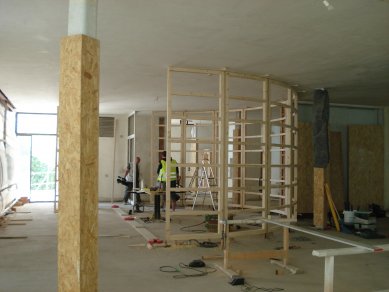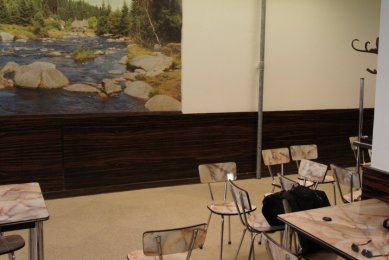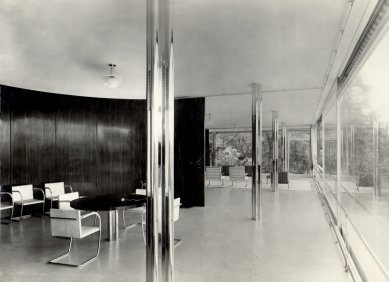
Expert found a piece of the wall from the Tugendhat villa in the Brno dining hall
Brno - During the restoration of the interior of the Tugendhat villa, Brno art historian Miroslav Ambroz made a unique discovery. He uncovered a portion of the original semicircular Makassar wall that bordered the dining room in the villa. The original wooden artifact was taken away by the Germans during World War II. Experts had considered it lost for decades, and restorers in the villa manufactured a copy. Ambroz found parts of the original in the cafeteria of the Brno Faculty of Law. For the past 20 years, guests in the cafeteria had been dining by the panels made of exotic wood with a troubled history, as reported today in a press release by A.M.O.S. Design.
Ambroz came across a diary kept by a German soldier in Brno during World War II. As a supporter of modern architecture, he included a mention of the removal of the Makassar wall among his notes. He identified the building where it was taken to in the text. Ambroz recognized it as today's Faculty of Law. He then found the panels in the cafeteria. The find was also confirmed to ČTK by the caretaker of the villa, Iveta Černá.
According to Černá, it is not impossible that the panels made of rare wood ended up in the student cafeteria. "When the Gestapo was located there (in the building), it was a social room. The wall was then moved to a representative room," she stated. Someone cut the wall before its new use and used it as wall paneling. Unlike in the villa, where the wood grain was oriented from top to bottom, the paneling was attached horizontally in its new location. No one recognized it for 70 years.
Restorers removed it from the wall in the cafeteria and transported it to the workshop. It will be returned to the villa, said Karel Říha from A.M.O.S. Design to ČTK.
The semicircular Makassar wall is considered one of the symbols of the Tugendhat villa. The monument as a whole is currently undergoing restoration. The renovation, costing 156 million crowns, is expected to be completed in January 2012. The villa will likely remain closed to the public for some time afterwards as the removed furnishings are moved back inside and the spaces are prepared for exhibition.
The Tugendhat villa is the only Czech building of modern art listed as a UNESCO World Heritage site. The villa was built according to the plans of the famous architect Ludwig Mies van der Rohe. The Tugendhat family enjoyed the house for only eight years. They emigrated in fear of the Nazis.
Ambroz came across a diary kept by a German soldier in Brno during World War II. As a supporter of modern architecture, he included a mention of the removal of the Makassar wall among his notes. He identified the building where it was taken to in the text. Ambroz recognized it as today's Faculty of Law. He then found the panels in the cafeteria. The find was also confirmed to ČTK by the caretaker of the villa, Iveta Černá.
According to Černá, it is not impossible that the panels made of rare wood ended up in the student cafeteria. "When the Gestapo was located there (in the building), it was a social room. The wall was then moved to a representative room," she stated. Someone cut the wall before its new use and used it as wall paneling. Unlike in the villa, where the wood grain was oriented from top to bottom, the paneling was attached horizontally in its new location. No one recognized it for 70 years.
Restorers removed it from the wall in the cafeteria and transported it to the workshop. It will be returned to the villa, said Karel Říha from A.M.O.S. Design to ČTK.
The semicircular Makassar wall is considered one of the symbols of the Tugendhat villa. The monument as a whole is currently undergoing restoration. The renovation, costing 156 million crowns, is expected to be completed in January 2012. The villa will likely remain closed to the public for some time afterwards as the removed furnishings are moved back inside and the spaces are prepared for exhibition.
The Tugendhat villa is the only Czech building of modern art listed as a UNESCO World Heritage site. The villa was built according to the plans of the famous architect Ludwig Mies van der Rohe. The Tugendhat family enjoyed the house for only eight years. They emigrated in fear of the Nazis.
The English translation is powered by AI tool. Switch to Czech to view the original text source.





5 comments
add comment
Subject
Author
Date
????
Lubomír Hruška
06.05.11 12:44
V menze
Jaroslav Matoušek
08.05.11 10:52
Do vily se zpět vrátí,..
Dr.Lusciniol
09.05.11 12:43
Román o vile Tugendhat
Ing.arch. Josef Myslivec
12.05.11 10:04
srovnání
vladimír ambroz
20.05.12 09:53
show all comments
Related articles
0
09.10.2020 | Fritz Tugendhat is primarily known as the owner of the famous villa in Brno
0
26.01.2012 | Vila Tugendhat has been renovated, and it is now being cleaned inside
0
16.11.2011 | In Brno, the renovation of the famous functionalist Villa Tugendhat is nearing completion
0
26.07.2011 | The Tugendhat Villa will open to the public in January 2012












